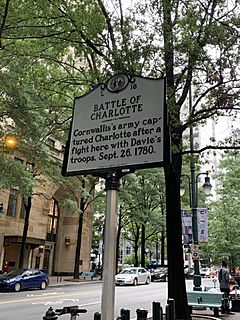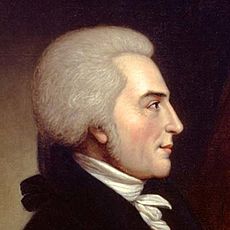Battle of Charlotte facts for kids
Quick facts for kids Battle of Charlotte |
|||||||
|---|---|---|---|---|---|---|---|
| Part of the American Revolutionary War | |||||||
 Plaque commemorating the Battle of Charlotte, located in Charlotte, North Carolina |
|||||||
|
|||||||
| Belligerents | |||||||
| Commanders and leaders | |||||||
| Strength | |||||||
| 150 | unknown | ||||||
| Casualties and losses | |||||||
| 23 to 30 killed, wounded or captured | 15 to 59 killed, wounded or missing. | ||||||
The Battle of Charlotte was a small but important fight during the American Revolutionary War. It happened in Charlotte, North Carolina, on September 26, 1780. This battle took place near the old Mecklenburg County Court House. Today, a tall building stands where the courthouse once was.
British soldiers, led by General Charles Cornwallis, were moving into town. They met a group of American fighters, called Patriots, led by William R. Davie. The Patriots were ready for them. A quick fight started, and a British leader named George Hanger was hurt. The small Patriot group soon pulled back as more British soldiers arrived.
Why the Battle Happened
The British had a plan to win the American Revolutionary War. They wanted to take control of the southern states. They had already captured Charleston, South Carolina, in 1780. They also defeated American forces in South Carolina.
After a big win at the Battle of Camden, British General Lord Cornwallis decided to move his army north. He wanted to deal with the remaining American soldiers in North Carolina. So, in mid-September, he started marching towards Charlotte, North Carolina.
American fighters, known as militia, watched Cornwallis's movements closely. One group, led by Major William R. Davie, stayed near the British. Davie's men surprised some British soldiers at Wahab's Plantation on September 20. After that, Davie moved to Charlotte. He set up a surprise attack to bother the first British soldiers entering the town.
Charlotte was a small town back then. Two main roads crossed in the center, where the Mecklenburg County courthouse stood. Davie placed his militia in three lines near the courthouse. One line was behind a stone wall that was about 3.5 feet (1.1 meters) high. He also put cavalry (soldiers on horseback) on the roads leading away from the courthouse. Finally, he hid 20 men behind a house on the southern road. This was where he expected the British to arrive first.
Normally, Cornwallis would send his fast cavalry, led by Lieutenant Colonel Banastre Tarleton, to check the town. But Tarleton was sick. So, Cornwallis gave the job to Major George Hanger. Cornwallis told Hanger to be careful and look for American fighters.
The Fight in Charlotte
Major Hanger and his cavalry did not follow Cornwallis's orders to be careful. They rode quickly into Charlotte. The 20 American men hidden behind the house fired at them. But Hanger's men kept riding. Then, they met heavy gunfire from the American militia behind the stone wall.
The first line of American militia moved to let the second line fire. Hanger thought they were running away, so he kept charging. This brought his men into a strong crossfire from the second line and the American cavalry on the sides. Hanger was wounded and fell. His cavalry quickly retreated in confusion.
Cornwallis heard the sounds of the battle and rode forward. He saw what was happening. He ordered his soldiers to attack again. By this time, more British soldiers were arriving. Seeing the larger British force, Davie decided to pull his American fighters back.
What Happened After
The Battle of Charlotte was a small fight. Some historians say the British had about 15 to 59 soldiers killed, wounded, or missing. The Americans had about 23 to 30 soldiers killed, wounded, or captured.
Major Hanger called the fight "a trifling insignificant skirmish." But it showed Cornwallis that the Americans would keep fighting. Hanger also became ill after the battle.
Instead of moving further north, Cornwallis decided to stay in Charlotte. But his army was never truly safe there. American militia groups kept bothering his soldiers. They made it hard for the British to get supplies or communicate.
In early October, a large group of Cornwallis's men was badly defeated at the Battle of Kings Mountain. Because of the constant attacks from American militia, Cornwallis eventually left Charlotte. He moved his army to Winnsboro, South Carolina, in November.



